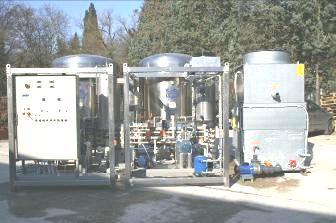Multiple Stage Evaporators - Automatic Discharge
These are for treatment of larger wastewater volumes. Energy from the first stage is used to supply the corresponding stages. Production capacity is from 2,600 to 13,200 gallons per day.
- The more stages used in evaporation, the less vapour needs to be supplied to the system, with a consequent decrease in the energy consumption fed to the boiler.
- Most commonly applied C&G evaporator
These evaporators are used to treat wastewaters from different types of industrial processes.
Energy, under the form of heat, has to be supplied when a solution must be evaporated. Electric energy is generally used to feed the refrigeration compressor in the vacuum evaporators, but when this is not possible, alternative energy sources can be used (methane, GPL, etc.).
The principle component of the evaporation costs is related to the expenses for heating and evaporating the solution which has to be treated.
Various methods have been studied to reduce this expense, and one of the most commonly used at an industrial level is multi-stage evaporation. There are a number of evaporators placed in series in these systems, and each of these is called a stage.
The solution which has to be concentrated is sent to the various boiling chambers, which each have a heat exchanger. Vapour circulates in the tubes of the heat exchanger and heats the solution which has to be treated, causing the evaporation.
The vapour used for the single stage evaporators has to be sufficient to allow all the solution to evaporate.
In the case of multiple stage evaporators, however, the evaporation process is divided into various stages and it is necessary to produce vapour only for the first stage.
These are for treatment of larger wastewater volumes. Energy from the first stage is used to supply the corresponding stages. Production capacity is from 2,600 to 13,200 gallons per day.
The more stages used in evaporation, the less vapour needs to be supplied to the system, with a consequent decrease in the energy consumption fed to the boiler.
Most commonly applied C&G evaporator
These evaporators are used to treat wastewaters from different types of industrial processes.
Energy, under the form of heat, has to be supplied when a solution must be evaporated. Electric energy is generally used to feed the refrigeration compressor in the vacuum evaporators, but when this is not possible, alternative energy sources can be used (methane, GPL, etc.).
The principle component of the evaporation costs is related to the expenses for heating and evaporating the solution which has to be treated.
Various methods have been studied to reduce this expense, and one of the most commonly used at an industrial level is multi-stage evaporation. There are a number of evaporators placed in series in these systems, and each of these is called a stage.
The solution which has to be concentrated is sent to the various boiling chambers, which each have a heat exchanger. Vapour circulates in the tubes of the heat exchanger and heats the solution which has to be treated, causing the evaporation.
The vapour used for the single stage evaporators has to be sufficient to allow all the solution to evaporate.
In the case of multiple stage evaporators, however, the evaporation process is divided into various stages and it is necessary to produce vapour only for the first stage.

